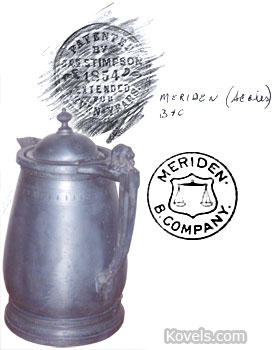Lyman’s Patent Pewter Pitcher
Q: I have a pewter pitcher that is lined with porcelain. There is a bear on the handle. There are several marks on the bottom, including “Patented by Jas Stimpson 1854,” “Lyman’s Patent, June 8, 1956,” and scales in a circle with the words “Meriden B & C.” I would like to know more about this pitcher.
A: The scales in a circle mark was used by Meriden Britannia Co., which was founded in 1852 in Meriden, Connecticut. It became one of the original members of the International Silver Co. in 1898. The company is still in business. The double-wall pitcher was invented by James Stimpson (born c.1780) of Baltimore in 1854. He called his invention an “ice pitcher.” It was a water pitcher with hinged lid, double sides, and double bottom, which insulated the pitcher and kept ice from melting. On June 8, 1858, William Worcester Lyman (1821-1891) of West Meriden, Connecticut, was issued a patent for an improved valve that fit in the throat of the nozzle of an ice or “refrigerating” pitcher and formed a tight seal when closed. Although your pitcher looks like pewter, it is made of Britannia metal, a mixture of tin, antimony, copper, and sometimes bismuth and zinc. Britannia metal is harder than real pewter. A double-wall pitcher like yours would sell for about $100 to $150.




Leave a Reply
You must be logged in to post a comment.